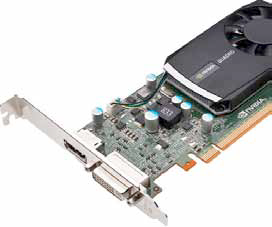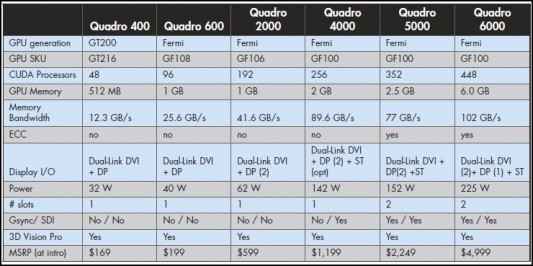The real competition for this entry-level professional graphics card is not something from AMD but Nvidia’s game-card line.
By Alex Herrera

Nvidia has completing an overhaul of its market-leading Quadro professional graphics line by introducing the latest and most aggressively priced member of the family, the Quadro 400. Nvidia has been actively targeting new workstation adopters for several years now, first with the Quadro FX 370 and 380, and now with the Quadro 400.
The FX models were based on the old workhorse G92 GPU, first released late in 2007. They were more a derivative of the earlier G80 generation than a new architecture. The Quadro 400, at first look, would seem to be the completion of a trickle down of Fermi technology through the professional line. But that turns out to not be the case. Instead of tapping a stripped-down—or functionality-binned—Fermi, Nvidia instead went back to an older GPU technology, the GT216 from its GT200 family, to power the Quadro 400. Why? It is all about price. Nvidia can give up some margin at the low-end, but it has to show a profit somehow. Fermi was never designed to be a low-cost architecture. Nvidia probably couldn’t make the numbers work (i.e., size, wafer cost, yields) to allow Fermi to play in a sub-$200 professional sandbox, although it seems to have done it in the consumer space with the low end GeForce AIBs.

Either that, or the now-well-amortized cost of the GT200 series (like Fermi, also built at 40 nm) was so compelling that the extra margin was worth cutting performance a bit. At the low end, price is more important than performance. Nvidia’s choices were a shrewd compromise, as the GT200 generation was no slouch. One might criticize the choice of the GT200 because it’s not DirectX 11 compliant like Fermi (rather 10.1), but if there’s a segment that cares less about such a deficiency, it’s the workstation market. Professional applications are still split on allegiance to DX versus OpenGL, and in either case, they don’t tend to push the latest versions of API, focusing instead on maximizing compatibility, stability and reliability.
Replacing the Quadro FX 300 series, the Quadro 400 hits a price point critical to expanding the market for both Quadro and the broader workstation market. Starting at an MSRP of $169 (and we imagine with a street price floating closer to $100 in the near term), the Quadro 400 will serve to entice new buyers of workstation-class hardware, specifically drawing appeal from one key vertical, 2D CAD, and one particular application within that vertical, AutoCAD.
AutoCAD users are a large untapped pool of would-be workstation users. Most still rely on consumer/corporate branded PCs with mainstream or gamer graphics hardware. To entice former GeForce buyers to move to Quadro, Nvidia has been consciously driving its low-end further down the price curve, hitting $100 with previous Quadro FX 300-class products.
 Nvidia released the Quadro 400 to coincide with Intel’s launch of the first Sandy Bridge processors, their new line of CPUs with integrated graphics. Mid-range and high-end workstations won’t see new platforms until Sandy Bridge—EP (a dual-socket version); entry level desktops get Sandy Bridge now. And since the vast majority of Quadro 400’s will end up in entry-level computers, the add-in board (AIB) launch really needs to be in sync with Intel’s low end.
Nvidia released the Quadro 400 to coincide with Intel’s launch of the first Sandy Bridge processors, their new line of CPUs with integrated graphics. Mid-range and high-end workstations won’t see new platforms until Sandy Bridge—EP (a dual-socket version); entry level desktops get Sandy Bridge now. And since the vast majority of Quadro 400’s will end up in entry-level computers, the add-in board (AIB) launch really needs to be in sync with Intel’s low end.
New CPUs don’t launch by themselves; they come out inside new computers. The Quadro 400 launch exploits the momentum from a host of OEM new models. Nvidia announced Q400 adoption from HP, Lenovo and Fujitsu, leaving Dell (for the moment), as the only OEM not supporting the Q400 as a launch option.
The price and timing were not arbitrary, and neither was the AIB Nvidia displayed in its PR as a comparison for the new Quadro 400. Instead of positioning the Q400 against an entry-level professional-class AMD board, Nvidia touted the Q400’s superiority over its own game-class GeForce GTX 580. The truth is, the GTX 580 is stealing more business from low-end Quadro than any AMD FirePro board. While AMD has made significant progress in the workstation graphics market in recent quarters, it currently holds 16.1% of the overall professional space, far behind Nvidia’s 83% share. Yes, AMD needs to be respected—and their current products appear to be putting price pressure on Nvidia—but there is a more important battlefront for the Quadro 400.
Remember the target audience we’re talking about here, mainstream AutoCAD users. There remains a pervasive perception that workstation-class AIBs are a money-making ruse being perpetrated on unsuspecting architects, mechanical designers, and stylists. Check any online user group, and you’ll find posts which blast professional AIBs as overpriced wallet-gougers, strongly urging people to buy consumer-class (i.e. GeForce) products, saying they deliver the same technology for a lot fewer dollars.
Combating such a perception is a bigger priority for Nvidia than one-upping a rival, at least when it comes to an AIB like the Quadro 400. In this context, Nvidia’s carefully crafted boast of 5X performance superiority over the GTX 580 makes perfect sense. While we can’t unilaterally verify the claim—and while we are sure Nvidia chose a metric that put the 400 in the best light—we don’t doubt the number. Professional AIBs like the Q400 enable subtle features that professional applications care a lot about, features that are an absolute don’t-care for GeForce buyers. Features like 30-bit (10 x R,G and B) color and AutoCAD smooth lines, for example, which render in hardware on a Quadro but fall back to software on a gamer AIB.
What do we think?
We think Nvidia knows what it’s doing in crafting and pitching a product like the Quadro 400. The company does little by accident and has the market share to show for it. Jon Peddie Research plans to review and benchmark the 400. We expect to find a capable AIB that makes a convincing case for its price/performance advantage over the gamer’s AIB du jour.
Alex Herrera is an analyst with Jon Peddie Research.





